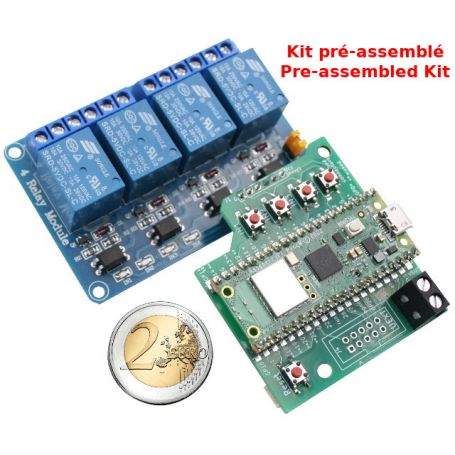WiFi 4 relay Module - MicroPython, OpenSource, Customisable
4 Relay WiFi module
- 4 Relay Module
- Raspberry-Pi Pico
- Adapter board (pre-assembled)
- MicroPython Software
- Local control (with button) + HTML + REST API
- Expandable
Payments are secured by LyraCollect, a French payment collection company.
It is possible to delivered to your home, to a pick-up point or picked up by appointment at MCHobby
We prepare, pack and ship your orders with great respect and care.
Relay board associated with Raspberry-Pi Pico Wireless microcontroler
An IoT exploration kit around one of the most popular Maker applications: relay module control.
This kit consists of a pre-assembled control board powered by Rapsberry-Pi Pico Wireless and a 4 optocoupled relais. A perfect kit to create a remote control system for appliances.
Finding the right combination of components to carry out your project, making connections (and testing them) can consume lot of resources... and without even having coded your first line of code yet!
This is where the WiFi-4-Relais kit comes handy. It takes care of the ready-to-use hardware parts and even offers examples script for MicroPython (around WiFi).
To facilitate the integration of sensors and other peripherals, a Qwiic/StemmaQT connector allows quick access to the I2C bus and the connection of cards from Adafruit or SparkFun. Olimex's UEXT connector carries power, serial bus, I2C bus and SPI bus using a standardized 10-pin IDC connector (see our UEXT collection or Olimex's UEXT products).
This product have everything you may need to accelerate your project developemnt:
- 4 relais: with optocoupler to control appliances.
The LEDs on the relay board indicates when the relay is activated. - 4 push button: to act on the project behavior/prototype.
- The Reset button: very handy to restart your software.
- Ready to use: just attach 6 pins from the controler board to the relay board.
Plug it with a connector, connect them with wire or just solder the two boards together THEN program it (or test it). - Raspberry-Pi Pico Wireless: the worldwide la carte microcontrôleur mondialement connue et reconnue.
It offers a Dual Core, WiFi (and Bluetooth) and can be programmed with many language (MicroPython, Arduino, Rust, C++, ...) - MicroPython ready: ready to be programmed in Python, the most popular language in the world.
The MicroPython demonstration script is already flashed on the board (see the tutorial). - Qwiic/StemmaQT: this connector can be used to quickly plug sensors and board made by SparkFun USA or Adafruit Industries.
- UEXT: a sturdy IDC 10 pins connector carrying I2C bus + SPI bus + UART and 3.3V power. Olimex Ltd manufacture many Industrial grade extension that could be plug on our project. See our UEXT range for more details.
- 5V Power (external / USB): everything is powered from 5V supply, either via the USB connector, either via the 5V screw terminal.
As USB does limit the current to 500 mA (as there is no negociation over USB) which is enough for 3 relais.
With external 5V power, all the relais can be activated at once.
The board schematic is available in the project repository.
The controler board is self-documented, you will find useful information about the GPIO usage under the board.
As mentionned in the remark on the top of the board: used GPIO are marked with double star **. Unreserved GPIOs, like those linked to buses, are marked with a single star * (you can use the GPIOs as bus or like GPIOs depending on your own needs)
Control board and relay board
The control board abd the relay board are not solder/tied together because
- You can arrange them depending on the space available (superposed into a case OR laying flat on a panel).
- When the controled appliance have a voltage over 12V, it is best to take away the controler board from the relay board.
In that case, you will need 6 wires to connect the board together.
Content
For each order, you will receive:
- The relay board
- The controler board (assembled and tested).
- The Pico-Wireless is soldered on the controler board. MicroPython and the demonstration script are loaded on the MicroPython file system.
Tutorial
- Discovering and mastering the WiFi-4-Relais (Github MCHobby)
With MicroPython example, REST and HTML demonstrator.








